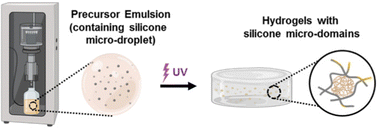Silicone-containing thermoresponsive membranes to form an optical glucose biosensor†
Abstract
Glucose biosensors that could be subcutaneously injected and interrogated without a physically connected electrode and transmitter affixed to skin would represent a major advancement in reducing the user burden of continuous glucose monitors (CGMs). Towards this goal, an optical glucose biosensor was formed by strategically tailoring a thermoresponsive double network (DN) membrane to house a phosphorescence lifetime-based glucose sensing assay. This membrane was selected based on its potential to exhibit reduced biofouling via ‘self-cleaning’ due to cyclical deswelling/reswelling in vivo. The membrane was strategically tailored to incorporate oxygen-sensitive metalloporphyrin phosphor, Pd meso-tetra(sulfophenyl)-tetrabenzoporphyrin ([PdPh4(SO3Na)4TBP]3) (HULK) and glucose oxidase (GOx). Specifically, electrostatic interactions and colvalent bonds were used to stabilize HULK and GOx within the membrane, respectively. Enhancing the oxygen permeability of the membrane was necessary to achieve sensitivity of HULK/GOx to physiological glucose levels. Thus, silicone microparticles were incorporated at two concentrations. Key properties of SiHy-0.25 and SiHy-0.5 microparticle-containing compositions were compared to a control having no microparticles (SiHy-0). The discrete nature of the silicone microparticles maintained the desired thermosensitivity profile and did not impact water content. While the modulus decreased with silicone microparticle content, membranes were more mechanically robust versus a conventional hydrogel. SiHy-0.25, owing to apparent phase separation, displayed greater glucose diffusion and oxygen permeability versus SiHy-0.5. Furthermore, SiHy-0.25 biosensors exhibited the greatest glucose sensitivity range of 100 to 300 mg dL−1versus only 100 to 150 mg dL−1 for both SiHy-0 and SiHy-0.5 biosensors.



 Please wait while we load your content...
Please wait while we load your content...